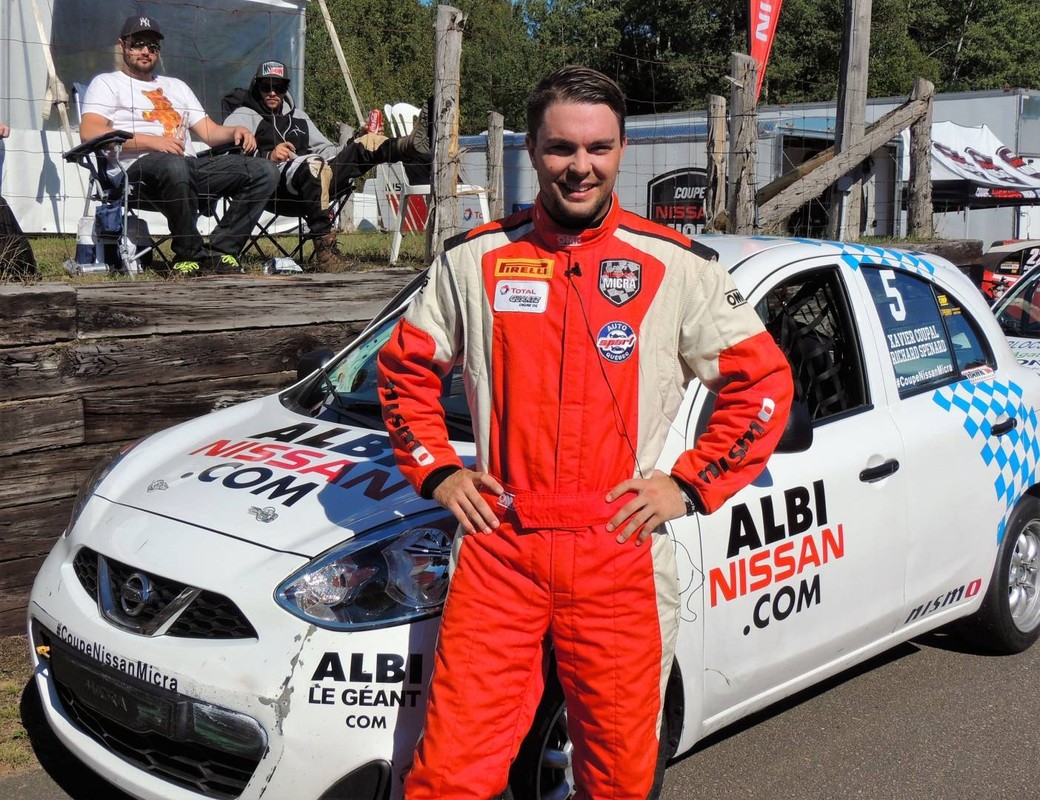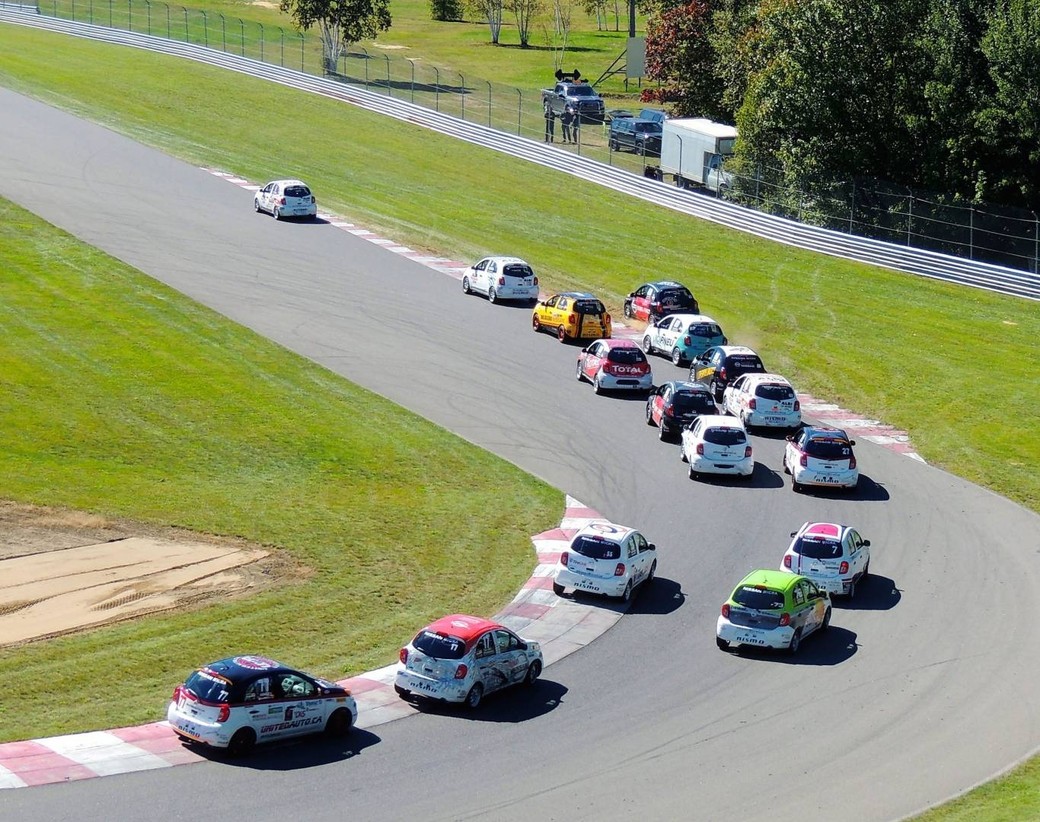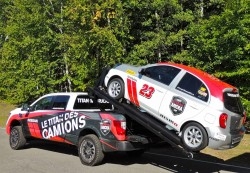
Micra Cup Finals Win Over New Race Fan
You needn’t be a die-hard motor sports fan to enjoy the Micra Cup.
I’m not and I did.
For those unfamiliar with the event, but may have seen the TV spots for Nissan’s smallest ride (remember Jim Parsons from Big Bang: “It’s hip to sip!”), it’s a race series based on the Micra subcompact.
Not the fancy, schmancy top-trim model that offers air conditioning, power locks and doors, upgraded fabrics, leather-wrapped steering and rearview monitor.

No, this race car begins with the bare-bones Micra that provides none of the above, but at $9,998 is more car than you’d think.
It is small – as the name would suggest – not much bigger than a Fiat 500. But it’s surprisingly roomy, and with the rear seats folded offers 820 litres of cargo space.
Power comes from a 16-valve, DOHC 1.6-litre four cylinder, making 109 hp and 107 lb/ft of torque.
I’ve driven the base Micra and it’s no slouch. Plant the pedal and it leaps forward, and with a wide track, small turning radius and wheels pushed to the corners, this 1,044 kg hatchback is surprisingly nimble.
But Micra Cup cars are stripped down to the bare essentials. Door panels, carpeting, seats, steering wheel (and airbags) are all removed to shed mass and maximize its already decent power-to-weight ratio.
The work on all cars is done by the MIA (Motorsports in Action) team in St-Eustache, where the car is gutted, and then refitted with a safety cage, NISMO suspension kit, FIA-approved racing seat, high-performance brake pads, Fastwheels with low-profile racing tires – and of course, a fire extinguisher.
A low-flow exhaust system is also installed. According to series founder and promoter Jacques Deshaies, it has little effect on performance but is needed “to increase the sound a little bit” noting the stock Micra is too quiet for racing.
Including vehicle price, a race-ready Micra will set you back $23,000 – and it comes with a racing suit.
Engine, five-speed manual transmission and brake assemblies are stock, ensuring a level playing field. Deshaies pointed out that with all cars being equal and strict limitations placed on equipment (i.e. you can buy a maximum of two new tires over the race weekend), Micra Cup is not about finding a sponsor with big dollars.

“It’s about the skill of the driver,” he added. “If you lose momentum, you’re done. You can’t make mistakes, and have to give it your full attention every second.”
Some drivers who are used to competing in higher-powered cars are hesitant to enter the series, but those who do “have so much fun with the car.”
A year earlier, I was invited to turn a few laps at the Circuit Mont-Tremblant, where the recent finals were now being held.
My expectations were exceeded as the lighter, tauter and more responsive Micra race car accelerated with a nice rasp, and delivered go-kart-like cornering on the 15-turn road course.
It pushed my limits, which still wouldn’t pass muster among the aggressive maneuvers and jockeying for position that took place during the Saturday and Sunday afternoon races that would determine the 2016 series winner.

The qualifier led to an anticipated duel between last year’s champion Olivier Bedard, and his teammate Xavier Coupal. Race one was dominated by the action at the front of the pack where Bedard tried to hold his position, but Coupal eventually took front spot and the victory – his eighth of the season.
Next day was equally rousing with Bedard in pole position where he led for a few laps, at least until Coupal took over. Nonetheless, Bedard was hard on his heels until the finish, keeping spectators on edge the entire time.
I’ll admit I was smitten. As one who has been lukewarm on motorsports, I can see how Micra Cup can – and should – win new fans.
And it is accessible to those wanting to enter the world of racing. Finding a sponsor for the car and the roughly $30K needed to pay for a season isn’t onerous for many businesses. You won’t need the likes of Virgin or Red Bull, and needn’t have the skills that would attract such deep pockets.
Some drivers, like Coupal and Bedard – and the fourth-place finisher Stefan Rzadzinski, with whom I chatted over the weekend – are fiercely competitive. Others are up-and-comers. There are even some “hobbyists,” who are content to duke it out with rivals at the back of the pack.

Despite the will to win, there’s camaraderie among the drivers, with those more seasoned offering advice to the novices. An extended family that during the awards presentation, really showed its support to all those having the courage and skills to compete.
Would I consider joining the men and women vying for the Micra Cup?
In a heartbeat. But my sponsor would probably be swapping cars as often as tires. And the tow truck would be on speed dial.
Micra Cup – a snapshot
- Second season – founded in 2015
- Presented by JD Motorsport and Nissan Canada
- 16 races across 8 week-ends in Ontario and Quebec, from May to September
- Race 1 (2016) was in Calabogie Motorsports Park
- All cars equally modified with safety cage, Nismo suspension, FIA-approved racing seat, high-performance brake pads, wheels and tires
- Stock powertrain: 1.6-litre inline four cylinder (109 hp, 107 lb/ft of torque), five-speed manual transmission
- Visit micracup.com for more information














